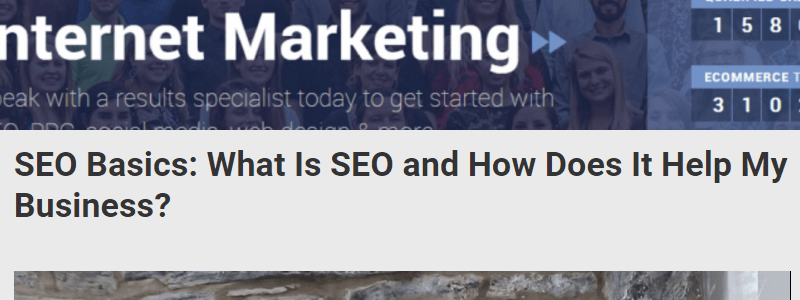-
 7 min. read
7 min. read
-
 Trevin Shirey
Trevin Shirey VP of Marketing
VP of Marketing
- Trevin serves as the VP of Marketing at WebFX. He has worked on over 450 marketing campaigns and has been building websites for over 25 years. His work has been featured by Search Engine Land, USA Today, Fast Company and Inc. Read his review of working with WebFX for the last 15 years.
In marketing, headlines are huge. You could write a book that turns your industry upside down and completely revamps the way a business operates. But if it doesn’t have a good title, nobody’s going to read it.
The same is true for blog posts and online content. It may sound easy to write a good headline, but considering what you have to say and the time you have to say it, it could be the hardest part of finishing a blog. So below, we worked out five awesome practices you can incorporate into your headlines.
1. Use 8 words per headline
 According to Content Marketing Institute, headlines that use eight words get 21% more clicks than the average blog post. That may not sound like a lot, but it’s an important starting point. Increasing the number of clicks you get on your posts is just the beginning since any of those clicks can turn into shares or links, which also get you more clicks.
According to Content Marketing Institute, headlines that use eight words get 21% more clicks than the average blog post. That may not sound like a lot, but it’s an important starting point. Increasing the number of clicks you get on your posts is just the beginning since any of those clicks can turn into shares or links, which also get you more clicks.
So if you want to get the most out of every blog you publish, aim for an eight-word headline. As for why this works, it’s not 100% clear. It could be that eight word-headlines just have a pleasing rhythm when people read them in their heads.
Or maybe it’s the perfect number of words you need to fully express an idea. Unfortunately, the research just isn’t there. Although if you have an idea for how to figure that out, you should definitely go for it — and maybe title your blog, “Why Eight Words Make the Perfect Blog Title.”
Bonus Read: How to Write for the Web
2. Use descriptive words in your headlines
 Your headline is a description of your blog post’s body, so you should use the most descriptive words in it that you can. According to HubSpot’s study of its blog and Twitter shares, the most impactful words to use are:
Your headline is a description of your blog post’s body, so you should use the most descriptive words in it that you can. According to HubSpot’s study of its blog and Twitter shares, the most impactful words to use are:
- “Template” (+114% shares)
- “Infographic” (+100% shares)
- Any number (Slight increase)
Other words like “guide” and “ebook” show a mild increase in clicks as well, but “template” and “infographic” are the top dogs. But all three of these words (or numbers) have something in common. They tell the reader exactly what to expect when they click to your blog.
If you say “template,” they know they’ll find an example or solution to something they want to fix. If you say “infographic,” they expect a visualized representation of data or concepts to help them understand something better. And if you use a number, they know they’ll be able to scan the main ideas of your blog post to see if any of them directly apply to their needs.
With that in mind, the strongest headlines you can write are short, descriptive, and straightforward. One compelling word in your headline would be enough to get more clicks than average.
3. Avoid hyperbole and overuse
 Since there are certain words that increase clicks, it makes sense that some of them decrease clicks as well. There are lots of these too, so we’ll just take a look at the top five:
Since there are certain words that increase clicks, it makes sense that some of them decrease clicks as well. There are lots of these too, so we’ll just take a look at the top five:
- Magic (-59%)
- Tip (-59%)
- Credit (-58%)
- How to (-49%)
- Simple (-49%)
Most of these (magic, how to, simple) are often used as overstatements to get clicks for articles that don’t deliver. Saying something is “magic” or “simple” could also be an oversimplification, while “how to” sounds like it promises an exact explanation of some complex process. Words like “tip” and “credit” are a little different.
“Tip” is overused in mainstream media, so it doesn’t have the same power as it once did. If you want to see an example, search “tips and tricks” in Google and look at the number of results. Instead, give your readers something more concrete.
Replace “tips” with words like:
- Designs
- Goals
- Images
- Thoughts
- Theories
- Impressions
- Estimates
- Takeaways
These words all give your readers a better idea about what your blog post will actually include instead of vaguely offering “tips.” This way, they know if they’re getting advice, concepts, opinions, recaps, or other news, which helps them decide whether to read. And if they don’t, you shouldn’t lose any sleep over it — “tips” would’ve statistically done much worse.
4. Profanity (mild)
 Over the past few years, profanity has become more acceptable in everyday conversation, even relating to business. Recently, it’s also started showing up in headlines.
Over the past few years, profanity has become more acceptable in everyday conversation, even relating to business. Recently, it’s also started showing up in headlines.
Marketing managers and CEOs have realized how easy it is to establish a brand’s personality with Internet marketing. That’s lead to some “edgier” companies trying new ideas that more traditional, family-oriented companies wouldn’t want to try. Like swearing in email headlines.
One great example of effectively using profanity (and shock value in general) is Noah Kagan. In the video below, he talks to Neville Medhora about the value of writing and how to write subject lines that get people to open emails. (If you’re at work right now, you should probably wear headphones since both of these guys have earned their reputations for vulgarity.)
Interestingly, this could be tied to the fact that profanity usage is a sign of intelligence.
(VERY OBVIOUS DISCLAIMER: This does not apply to slurs or epithets.) It could also have something to do with the fact that mild profanity creates a more casual tone. Unless there are kids around or you’re in a professional environment, you probably drop a few F-bombs around your friends on occasion — or when you’re driving. But while you want to make someone feel like they’re talking to a friend, you don’t want to convey the same anger, irritation, or other negative emotions that could be associated with it.
Unless that’s part of your brand, anyway. This concept works best for startups or companies that want to establish an edgy brand. It probably wouldn’t work for more traditional companies like Chase Bank, General Electric, or a children’s book publisher since they set their brands apart from that kind of conversation.
5. Audience relation
 One of the best ways to capture the attention of an audience is to relate to that audience. You can do that by referencing the audience in your headline to pique their curiosity. If there’s a common problem in your industry or a consistent need among your customers, use that to make the best possible headline.
One of the best ways to capture the attention of an audience is to relate to that audience. You can do that by referencing the audience in your headline to pique their curiosity. If there’s a common problem in your industry or a consistent need among your customers, use that to make the best possible headline.
A Norwegian study arrived at this conclusion by testing several headlines on a shopping website.
- For sale: Black iPhone 4 16GB
- Anyone need a new iPhone4?
- Is this your new iPhone4?
The first headline looks like the typical hook you’d see in a store. The second one looks like a sketchy ad on Craigslist for someone trying to get rid of an old phone. But the last one hits a different part of the brain altogether, because it appeals to the person reading it directly.
It almost feels like the headline speaks to you when you read it. And better yet, it tells the reader the one key point that they always want to know — what do I get from clicking this headline? Naturally, that headline worked the best.
Instead of saying “Buy this iPhone,” it made people wonder “Should I buy this iPhone?”
How do these practices work for you?
Have you incorporated any of these ideas into your headlines? How have they worked? Let me know in the comments!
-
 Trevin serves as the VP of Marketing at WebFX. He has worked on over 450 marketing campaigns and has been building websites for over 25 years. His work has been featured by Search Engine Land, USA Today, Fast Company and Inc. Read his review of working with WebFX for the last 15 years.
Trevin serves as the VP of Marketing at WebFX. He has worked on over 450 marketing campaigns and has been building websites for over 25 years. His work has been featured by Search Engine Land, USA Today, Fast Company and Inc. Read his review of working with WebFX for the last 15 years. -

WebFX is a full-service marketing agency with 1,100+ client reviews and a 4.9-star rating on Clutch! Find out how our expert team and revenue-accelerating tech can drive results for you! Learn more
Try our free Marketing Calculator
Craft a tailored online marketing strategy! Utilize our free Internet marketing calculator for a custom plan based on your location, reach, timeframe, and budget.
Plan Your Marketing Budget

Proven Marketing Strategies

Proven Marketing Strategies
Try our free Marketing Calculator
Craft a tailored online marketing strategy! Utilize our free Internet marketing calculator for a custom plan based on your location, reach, timeframe, and budget.
Plan Your Marketing Budget
What to read next





